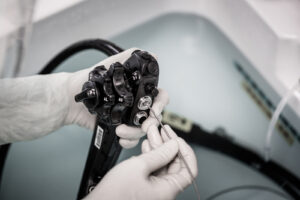 Patient safety is a top priority in healthcare. Unfortunately, despite the measures that healthcare organizations take to keep patients safe and healthy, healthcare-acquired infections (HAIs) are a significant cause of illness and even death. The U.S. Department of Health and Human Services (HHS) says that at any given time, nearly 1 in 31 patients receiving in-patient care have an infection related to their hospital care.
Patient safety is a top priority in healthcare. Unfortunately, despite the measures that healthcare organizations take to keep patients safe and healthy, healthcare-acquired infections (HAIs) are a significant cause of illness and even death. The U.S. Department of Health and Human Services (HHS) says that at any given time, nearly 1 in 31 patients receiving in-patient care have an infection related to their hospital care.
A subset of these HAIs is endoscope-associated infections, which are caused by contaminated endoscopes that were not correctly reprocessed and sterilized. In October 2021, the American Journal of Gastroenterology issued an analysis of studies published from 2010 to 2020 and revealed that nearly 20% of reprocessed patient-ready gastrointestinal endoscopes may be contaminated with microorganisms.
Standards for reprocessing are necessary to reduce endoscope-associated infections. Organizations such as the Centers for Disease Control and Prevention (CDC), the Society of Gastroenterology Nurses and Associates and the Association for the Advance of Medical Instrumentation (AAMI) have all issued recommendations and guidelines for endoscope reprocessing programs.
In 2016, the Healthcare Infection Control Practices Advisory Committee (HICPAC) and the CDC issued a report that recommended ways to reduce the risk of endoscope- and instrument-related HAIs.
In the report, the CDC and HICPAC say that healthcare facilities “should have a reliable, high-quality system for endoscope reprocessing which minimizes infection risks.” The report gives seven essential steps for high-quality cleaning and reprocessing:
- Pre-cleaning. Following the device manufacturer’s instructions, staff should perform pre-cleaning immediately after the completion of the endoscope procedure to help prevent biofilm from forming.
- Leak testing. If the endoscope requires leak testing, it should be performed after each use and prior to the manual cleaning. This helps detect damage to the endoscope.
- Manual cleaning. Manual cleaning should be meticulous—and include “brushing and flushing channels and ports” consistent with the manufacturer’s instructions for use. HICPAC and the CDC call this “the most critical step in the disinfection process.”
- Visual inspection. Reprocessing staff should conduct a thorough visual inspection of the endoscope and its accessories to ensure that they are clean and free of defects.
- Disinfection or sterilization. After manual cleaning and visual inspection are complete, a high-level disinfection or sterilization should be performed in accordance with the manufacturer’s instructions for use.
- Storage. When cleaning and reprocessing is complete, endoscopes and accessories should be stored in a way that prevents recontamination, protects against damage and promotes drying.
- Documentation. Documentation of each step’s completion is necessary each time an endoscope is reprocessed for quality assurance purposes.
Why Drying and Storage Cabinets Are a Critical Part of Reprocessing
In March 2022, the AAMI released a report with a revised set of endoscope reprocessing guidelines. The AAMI’s updated recommendations include a “heightened focus on endoscope drying,” because the presence of moisture can increase the risk of infection, and storage recommendations.
Research, which was published in a 2008 issue of the Journal of Hospital Infection, found that when endoscopes were stored in a drying and storage cabinet, the “microbial contamination levels on endoscopes were lower than the number of bacteria initially introduced and could decrease considerably thereafter.” For endoscopes that were stored outside of the drying storage cabinet, the microbial numbers stayed the same or increased.
In the past, the AAMI wrote in a 2020 report, “many facilities stored patient-ready endoscopes in transport bins, in original endoscope boxes with foam inserts, and upright in cabinets with and without air flow.” Instead, the organization writes, storage solutions should have active air circulation, forced-air designs or both.
At Storage Systems Unlimited, we offer the InnerSpace Ventaire Scope Drying and Tracking Cabinet, which is compatible with all major endoscope brands, along with offerings from other manufacturers. “The Ventaire cabinet includes an automated system that provides consistent and continuous delivery of HEPA-filtered, pressurized air into all endoscope channels to keep scopes dry and vented,” InnerSpace explains.
The Ventaire cabinet’s 10-inch display screen shows real-time information, including endoscope locations, storage times, channel availability, and the temperature and humidity level inside the cabinet. It also displays the time before scopes are expired, and the system can generate a report detailing all scope activity—including when they are checked in and checked out.
Using the cabinet can help hospitals and healthcare organizations reduce the number of endoscope-associated infections and improve patient safety. To learn more or to get pricing on the InnerSpace Ventaire Scope Drying and Tracking Cabinet, contact us at 1-888-614-0004.
